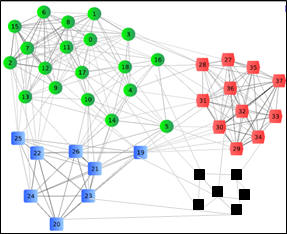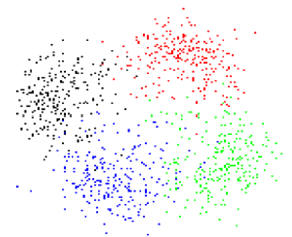
Figure 1. A network graph of 4-communities.

Figure 2. The Synthetic coordinates representation of a 4-communites network.
|
Introduction This work is focused on finding the entire community structure of a network, based on local interactions between neighboring nodes and on an unsupervised distributed hierarchical clustering algorithm (see Figure 1). The novelty of the proposed approach is the fact that the algorithm is based on the use of network coordinates computed by a distributed algorithm (see Figure 2). We reduce the graph clustering problem (see Figure 1) to points clustering (see Fig. 2) that can be solved using centralized clustering algorithms like k-means [1-2] or distributed clustering algorithms [3]. Experimental results and comparisons with other methods from literature are presented for a variety of benchmark graphs with known community structure, derived by varying a number of graph parameters and real data sets. The experimental results and comparisons to existing methods with similar computation cost on real and synthetic data sets demonstrate the high performance and robustness of the proposed scheme.
|
 Figure 1. A network graph of 4-communities. |
 Figure 2. The Synthetic coordinates representation of a 4-communites network. |
|
Methodology The proposed local community finding
algorithm [3] comprises the following steps:
Phase 1: Network coordinates
Figure 3. The two types of physical springs for connected nodes (traction) and non-connected nodes (turning away) .
Phase 2: Distributed Clustering algorithm
|
|
Downloads
|
|
Related Publications [1]. H. Papadakis, C. Panagiotakis and P. Fragopoulou, Locating Communities on Real Dataset Graphs Using Synthetic Coordinates, Parallel Processing Letters (PPL), vol. 22, no. 1, Jan. 2012.[2]. H. Papadakis, C. Panagiotakis and P. Fragopoulou, Locating Communities on Graphs with variations in Community Sizes, Journal of Supercomputing, vol. 185, no.1, pp. 9-15, Jan. 2012. [3]. H. Papadakis, C. Panagiotakis and P. Fragopoulou, Distributed Community Detection in a Complex World Using Synthetic Coordinates, Journal of Statistical Mechanics, 2014 (under revision).[4]. H. Papadakis, C. Panagiotakis and P. Fragopoulou, Local Community Finding using Synthetic Coordinates, International Conference on Future Information Technology (FutureTech 2011), 2011 (Best Paper Award). [5]. A. Kalaitzakis, H. Papadakis, C. Panagiotakis and P. Fragopoulou, Community Detection in Collaborative Environments: A Comparative Analysis, International Conference on PErvasive Technologies Related to Assistive Environments, 2011. [6]. H. Papadakis, C. Panagiotakis and P. Fragopoulou, Distributed Community Detection: Finding neighborhoods in a complex world using synthetic coordinates, IEEE symposium on Computers and Communications, 2011.[7]. Frank Dabek, Russ Cox, Frans Kaashoek, and Robert Morris. Vivaldi: A decentralized network coordinate system. In Proceedings of the ACM SIGCOMM ’04 Conference, August 2004. [8] C. Panagiotakis, H. Papadakis, E. Grinias, N. Komodakis, P. Fragopoulou and G. Tziritas, Interactive Image Segmentation Based on Synthetic Graph Coordinates, Pattern Recognition, vol. 46, no. 11, pp. 2940-2952, Nov. 2013. [9] C. Panagiotakis, H. Papadakis, E. Grinias, N. Komodakis, P. Fragopoulou and G. Tziritas, Interactive Image Segmentation via Graph Clustering and Synthetic Coordinates Modeling, International Conference on Computer Analysis of Images and Patterns, 2013.
Acknowledgments: This work is partially supported by the “ARCHIMEDE III: Education and Lifelong Learning” (Project’s Acronym: P2PCOORD) project.
|